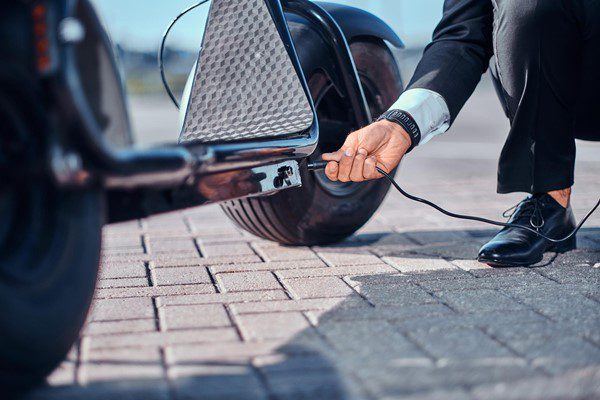If you bought a bike in the past year, it’s likely an electric bike. Electric bikes are the type of bike that is growing the fastest in the U.S. right now. In 2021, they will be bigger than road bikes and be the third-biggest type of bike overall. Why do e-bikes sell more than electric cars? The electric motor on an e-bike is small and lightweight, but it gives a powerful boost to all kinds of riding, especially utilitarian riding like commuting and running errands.
At the heart of that design is a strong battery made from lithium. Taking care of that battery properly is the key to safely getting the best range and most extended battery life. Here is what you need to know about how to charge the battery in your e-bike.
How to Charge Safely
Kunal Kapoor, a senior manager for quality and compliance at Bosch, a top maker of e-bike motor systems, says that you should charge your battery inside, on the correct charger, and with the motor system turned off. He says that while e-bike motors, batteries, and wiring can handle the weather, chargers aren’t meant to be used outside.
Using the correct charger is mostly a matter of safety. when the battery tells the charger it’s ready to be charged with a modern lithium battery, the charger’s battery monitoring system ensures that the temperatures inside the battery are optimal for receiving the charge shuts off if necessary.
Even if an off-brand charger has the same output rating, it doesn’t have all the features of that battery management system. This means that current can flow to the battery even if the temperature increases, which is dangerous and could cause a fire. Even though the chance of a battery fire is low, Kapoor says that people shouldn’t leave batteries charging alone.
You can charge the battery while it’s on the bike or takes it off, as long as it’s not on or near anything that could catch fire. If you’re looking for cheaper e-bikes with house-brand or unbranded motor and battery systems, ensure the battery and charger have a UL 2849 certification stamp from Underwriters Laboratories.
This is the standard for how safe electrical systems and charging batteries for e-bikes should be. Some bike shops won’t work on e-bikes without this stamp because it could cause a fire if the bike is left in the shop overnight.
How to maximize the battery’s range and length of life
First, let’s talk about what things are. The range is mostly runtime, which is how many miles you can ride on a single charge of the battery. Even on the same bike, the field will be different. A flat ride to work with just a light backpack will give you better content than a ride home from Costco with a full load. Depending on these things, most e-bikes today can go between 25 and 75 miles.
Lifespan is the number of times a battery can be used and recharged before it loses a lot of power. When the capacity starts to go down, you won’t feel less power while riding, but the range will begin to go down. A standard measure of how long an e-bike battery will last is 500 “full” discharge/recharge cycles.
This is about three to five years of everyday use before the battery’s capacity drops noticeably. Even though battery range and battery life are not the same things, they are linked, and actions that decrease range will also, over time, shorten battery life. Kapoor says that running the motor difficult, like leaving it in Boost or Turbo method all the time, is a big problem.
This means that a ride of a certain distance depends more and more on motor power than when the assist level is lower. You’ll charge and drain the battery more often, which will shorten its life. The pedal cadence is less obvious and stresses motors and batteries. Most e-bike motors work best when the pedaling rhythm is between 70 and 90 rpm.
If you pedal too fast, you can waste energy. More often, efficiency isn’t at its best because the rider pedals too gradually in a large gear. This is similar to lugging the engine in a car; whether the car uses gas or electricity, the motor has to work harder. Pick your gears wisely to stay in that 70–90 rpm sweet spot.
Mistakes That Drain Your Battery
When you buy a new e-bike, the battery has probably been inactive for a while, so you should fully charge it before riding it. But lithium batteries don’t have memory, so they don’t need to be fully drained and fully charged every time to keep their full power. It’s best not to run a battery lower than zero.
He says that if you let the battery die down, it may be damaged for good, and it will never be able to be charged to its total capacity again. Kapoor says that if you don’t ride the bike for a few weeks or more, store it (or at least the battery) in a dry, big room with the battery between 30 and 60 percent charged.
That’s the most stable level for long-term storage, and it will lower the chance of a deep discharge that would hurt your battery. Don’t leave your battery charger plugged in for a long time. It’s unnecessary and can cause a short cycle of discharging and charging, reducing the battery’s capacity in the long run.
If you don’t ride the bike for a long time, check the battery charge once a month and partially charge it when it drops below 30%. Lithium batteries are less affected by cold weather than other batteries, so unless it’s freezing, you shouldn’t notice a decrease in range while riding.
But researchers at the Energy Department recently found that storing lithium batteries below cooling for extended periods can damage part of the cathode, lowering the battery’s capacity. Also, lithium batteries don’t charge well when it’s cold outside. Kapoor says that if you live where it gets below freezing, you should bring the bike’s battery inside when it’s not being used.
Also, don’t let your battery sit next to a window that gets a lot of suns or in a hot car. Extra heat can cause a battery’s temperature to rise enough to damage its parts. In the worst case, it can cause “thermal runaway,” when a storm starts to heat itself in an unstable, uncontrollable way that can lead to a fire.
You don’t have to charge your phone after every ride. Filling up your battery might seem like a good idea, but over time it will lose power faster. If a charge lasts 50 miles and you ride 10 miles daily, you only have to charge your bike every three or four days.
Don’t rush the charging process. So-called fast chargers are tempting because they can quickly bring a battery back to full power in a short amount of time. But fast charging has a downside: it cuts down on the number of times a battery can be charged before it dies. Use the charger that came with your system. If you need to set it quickly, turn off the charger when the battery is about 90% charged.
If there is a fire
Battery fires are rare, but they do happen. If your battery gets too hot to touch while charging, unplug the charger immediately. If you can, put the battery in a metal bucket or, better yet, a bucket filled with sand and keep it away from anything that could catch fire.
But if it’s too dangerous to handle, call 911 immediately and tell the dispatcher it’s a lithium battery fire, which needs to be put out differently than other fires. Don’t pour the water on a battery fire. Water and lithium react to make hydrogen, which is very flammable. In the case of a fire, a regular fire extinguisher might help, but you might also need other tools.



